The Intel 9th Gen Review: Core i9-9900K, Core i7-9700K and Core i5-9600K Tested
by Ian Cutress on October 19, 2018 9:00 AM EST- Posted in
- CPUs
- Intel
- Coffee Lake
- 14++
- Core 9th Gen
- Core-S
- i9-9900K
- i7-9700K
- i5-9600K
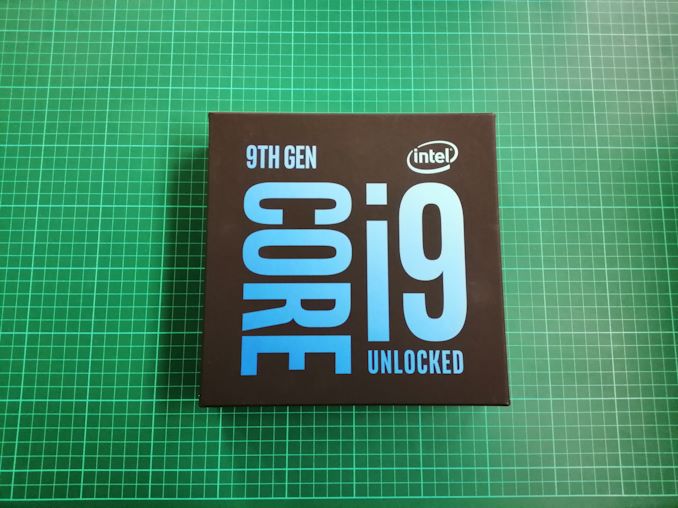
Intel’s newest line of desktop processors bring with them a number of changes designed to sway favor with performance enthusiasts. These new parts bring Intel’s consumer processors up to eight cores, with higher frequencies, better thermal connectivity, and extra hardware security updates for Spectre and Meltdown. The only catch is that you’re going to need a large wallet and a big cooler: both price and power consumption hit new highs this time around.
Coffee Lake Refresh: A Refresher
Our coverage of Intel’s announcement last week went into detail about the three new processors being launched today. But here’s a quick reminder of the latest silicon in the market.
Today, three CPUs are being launched: the 8-core Core i9-9900K capable of hitting 5.0 GHz out of the box, an 8-core Core i7-9700K that’s a bit cheaper, and a 6-core Core i5-9600K that on paper looks like it could be a killer purchase.
| Intel 9th Gen Core | |||||||||
| AnandTech | Cores | TDP | Freq | L3 | L3 Per Core |
DRAM DDR4 |
iGPU | iGPU Turbo |
|
| Core i9-9900K | $488* | 8 / 16 | 95 W | 3.6 / 5.0 | 16 MB | 2.0 MB | 2666 | GT2 | 1200 |
| Core i7-9700K | $374* | 8 / 8 | 95 W | 3.6 / 4.9 | 12 MB | 1.5 MB | 2666 | GT2 | 1200 |
| Core i5-9600K | $262* | 6 / 6 | 95 W | 3.7 / 4.6 | 9 MB | 1.5 MB | 2666 | GT2 | 1150 |
| 8th Gen | |||||||||
| Core i7-8086K | $425 | 6 / 12 | 95 W | 4.0 / 5.0 | 12 MB | 2 MB | 2666 | 24 EUs | 1200 |
| Core i7-8700K | $359 | 6 / 12 | 95 W | 3.7 / 4.7 | 12 MB | 2 MB | 2666 | 24 EUs | 1200 |
| Core i5-8600K | $258 | 6 / 6 | 95 W | 3.6 / 4.3 | 9 MB | 1.5 MB | 2666 | 24 EUs | 1150 |
| Core i3-8350K | $179 | 4 / 4 | 91 W | 4.0 | 8 MB | 2 MB | 2400 | 24 EUs | 1150 |
| Pentium G5600 | $93 | 2 / 4 | 54 W | 3.9 | 4 MB | 2 MB | 2400 | 24 EUs | 1100 |
| * This is SEP, or 1k unit price. MSRP is expected to be slightly higher | |||||||||
The new halo product is the Core i9-9900K, Intel’s first mainstream desktop socketable processor to have the Core i9 naming. This is an eight-core, sixteen thread processor, Intel’s first in this product line. It offers a base frequency of 3.6 GHz and a peak turbo frequency of 5.0 GHz – which is actually a two-core turbo as we go into below. This is an overclockable processor, allowing users to push the frequency if the cooling is sufficient, and despite the memory controller still rated at DDR4-2666, higher speed memory should work in almost every chip. The Core i9-9900K also gets a fully-enabled cache, with 2 MB available per core for a chip-wide total of 16 MB. There’s also some integrated graphics, the same UHD 630 graphics we saw on the previous generation. This all comes in at a $488 suggested retail price, although no cooler is bundled.
The Core i7 now sits in the ‘middle’ of the set, but the Core i7-9700K is seemingly no slouch. Intel has done away with hyper-threading on this part, giving it eight cores and eight threads only, however it does have a base frequency of 3.6 GHz and a turbo frequency of 4.9 GHz. For this part Intel has reduced the L3 cache per core to 1.5 MB, which might have an affect on some software, but the processor is overclockable and features the same DDR4-2666 support as the Core i9. The $374 suggested retail price is a bit easier to digest for sure, with the user safe in the knowledge that no two threads are sharing resources on a single core. This chip will be an interesting comparison to the last generation Core i7-8700K, which has two fewer cores but has hyper-threading.
The Core i5-9600K suddenly becomes the baby overclocking chip, but still commands a $262 price, a few dollars more than the Core i5-8600K but in exchange for extra frequency and all the extras listed later in this article. For the money, this chip has a base frequency of 3.7 GHz and a turbo frequency of 4.6 GHz, along with the same DDR4-2666 support and UHD 630 graphics.
All three parts are the first entrants into Intel’s 9th Generation Core product line, and under the hood they feature a refresh of the Coffee Lake architecture we saw in the 8th Generation Core products. They are built on Intel’s 14++ manufacturing node, the latest node which prioritizes high frequency and performance. The key highlights of this set of three processors, asides from all being overclockable, comes down to what Intel has done under the hood.
Per Core Turbo Ratios
In our information escapades, we were able to obtain the per-core turbo values for each processor. Intel still classifies this information as ‘proprietary’, so does not distribute it. However Intel’s partners are more than happy to give us the information, given that it has to be coded into the system BIOS anyway.
The big uplift here is that 5.0 GHz turbo. In our Core i7-8086K review, where Intel was happy to promote that chip as its first 5.0 GHz product, the fact that the 5.0 GHz value was on a single core was actually a downside – no matter how we tested the processor, there is usually enough running on more than one core that no user ever realistically sees 5.0 GHz at all. We only ever managed to see it flick up momentarily while waiting at idle. But the fact that the Core i9-9900K now has it across two cores means that we are more likely to see this high frequency in our single-threaded testing.
More Coffee, Less Caffeine: Hyper-Threading and L3 Cache
All this aside, it would appear that Intel is also forgoing hyper-threading on most of its processors. The only Core processors to get hyper-threading will be the Core i9 parts, and perhaps the Pentiums as well. This is partly to help make the product stack more linear, and so cheaper chips are not treading on the toes of the more expensive ones (e.g. though unlikely, a quad-core with hyper-threading might outperform a 6-core without). The other angle is one of the recently discovered side-channel attacks that can occur when hyper-threading is in action. By disabling hyper-threading on the volume production chips, this security issue is no longer present. It also ensures that every thread on that chip is not competing for per-core resources.
One of the more interesting dissections of the new 9th Generation product is in the L3 cache per core for the different models. In previous generations, the Core i7 parts had 2 MB of L3 cache per core, while the Core i5 had 1.5 MB of L3 cache per core, and the Core i3 was split between some with 2MB and others with 1.5MB. This time around, Intel is only putting the full cache on the highest Core i9 parts, and reducing the Core i7 to 1.5MB of L3 per core. This will have a slight knock-on effect on performance, which when we get the processors will be an interesting metric to test.
Integrated Graphics
One topic that Intel has not focused on much in several generations (since Broadwell, really) is that of integrated graphics. All the chips announced for the 9th generation family will still have the same GT2 configuration as the 8th generation, including the new Core i9 parts. Officially these come under the 8+2 designation. Intel still believes that having a form of integrated graphics on these high-end, overclockable processors, is still a value addition to the platform. The only downside is the performance, and it won’t be winning any awards soon.
The graphics will still be labelled as UHD Graphics 630, and use the same drivers as the 8th gen family.
Coffee Lake Refresh: Learning from the GPU Companies
Intel’s 9th Generation Core family is built around the Coffee Lake platform, and as the processors have not had any microarchitectural changes, they are refreshes of the 8th generation parts but with the product stack laid out a little differently. For those keeping track, Coffee Lake was already a rehash of Kaby Lake, which was an update to Skylake. So we are on Skylake Refresh Refresh Refresh. Making for what's essentially the same 2015 core CPU microarchitecture now going into 2018 (and beyond).
| Intel's Core Architecture Cadence | |||||
| Core Generation | Microarchitecture | Process Node | Release Year | ||
| 2nd | Sandy Bridge | 32nm | 2011 | ||
| 3rd | Ivy Bridge | 22nm | 2012 | ||
| 4th | Haswell | 22nm | 2013 | ||
| 5th | Broadwell | 14nm | 2014 | ||
| 6th | Skylake | 14nm | 2015 | ||
| 7th | Kaby Lake | 14nm+ | 2016 | ||
| 8th | Kaby Lake-R Coffee Lake-S Kaby Lake-G Coffee Lake-U/H Whiskey Lake-U Amber Lake-Y Cannon Lake-U |
14nm+ 14nm++ 14nm+ 14nm++ 14nm++ 14nm+ 10nm |
2017 2017-2018 2018 2018 2018 2018 2017* |
||
| 9th | Coffee Lake Refresh | 14nm** | 2018 | ||
| Unknown | Ice Lake (Consumer) | 10nm? | 2019? | ||
| Cascade Lake (Server) Cooper Lake (Server) Ice Lake (Server) |
14nm** 14nm** 10nm |
2018 2019 2020 |
|||
| * Single CPU For Revenue ** Intel '14nm Class' |
|||||
Intel has promised that its 10nm manufacturing process will ramp through 2019, and has already announced that it will introduce Ice Lake for servers on 10nm in 2020, after another run of 14nm with Cooper Lake in 2019. On the consumer side, the status is still in limbo – with any luck, the next generation of consumer parts will be a proper update to the microarchitecture, regardless of the process node.
I’ve had an 8-Core for Years!
Depending on where you draw the line for ‘consumer’ processors, technically we have had 8-core Intel CPUs on the high-end desktop space for a number of years. The Core i7-5960X was released in August 2014, and features eight Haswell cores on the HEDT platform, with quad-channel DDR4-2133 memory and 44 PCIe lanes at 140W. Back then, on Intel’s 22nm process, the die size was around 355.52 mm2.
Back when Intel launched the first Coffee Lake processors, the 6+2 die design of the i7-8700K was around ~151 mm2, an increase of ~26mm2 over the 4+2 design of the i7-7700K (~125mm2). Back then, that was a jump from Intel’s official 14+ to 14++ manufacturing nodes, which due to a relaxed fin pitch made everything a bit bigger anyway.
But if we take 26mm2 on the high end of adding a pair of cores to the die size, then we can predict that the 8+2 design of the Core i9-9900K should come in around ~177 mm2, or a 17% larger die size. At 177mm2 including integrated graphics, this would be half the size of the Core i7-5960X, although with only half the memory controllers and PCIe lanes too. Even with that, it’s a sizeable decrease.
Naïvely one might suggest that a 17% increase in die area might directly translate to a 17% increase in price. A 17% increase in the tray price of the Core i7-8700K puts it in the region of $420, whereas the official pricing is at $488 for the K-equivalent processor. Given how Intel bins its chips (one die can be sold for half as much as another), it is hard to say how much this $488 increases profit margins, although it is widely expected that it will.
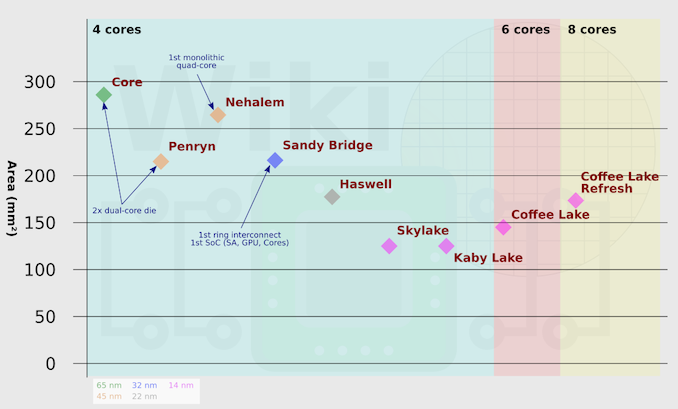
Die sizes from Wikichip
If we look at die sizes of the top end chips, through the decade of quad cores the die size was actually decreasing, from the quad core of Nehalem at over 260 mm2, down to Kaby Lake at 125 mm2. It has now steadily increased as more and more cores have been added. It might be crazy to think that Intel would happily spend 260+ mm2 on a mainstream silicon die today on its latest manufacturing process.
Over on the next page, we’ll cover Spectre/Meltdown fixes and discuss the updates to Intel’s STIM strategy.
Pages In This Review
- Coffee Lake Refresher
- Spectre, Meltdown, and STIM
- Test Bed and Setup
- 2018 and 2019 Benchmark Suite: Spectre and Meltdown Hardened
- CPU Performance: System Tests
- CPU Performance: Rendering Tests
- CPU Performance: Office Tests
- CPU Performance: Encoding Tests
- CPU Performance: Web and Legacy Tests
- Gaming: World of Tanks enCore
- Gaming: Final Fantasy XV
- Gaming: Shadow of War
- Gaming: Civilization 6
- Gaming: Ashes Classic
- Gaming: Strange Brigade
- Gaming: Grand Theft Auto V
- Gaming: Far Cry 5
- Gaming: Shadow of the Tomb Raider
- Gaming: F1 2018
- Gaming: Integrated Graphics
- Power Consumption
- Overclocking
- Conclusions and Final Words


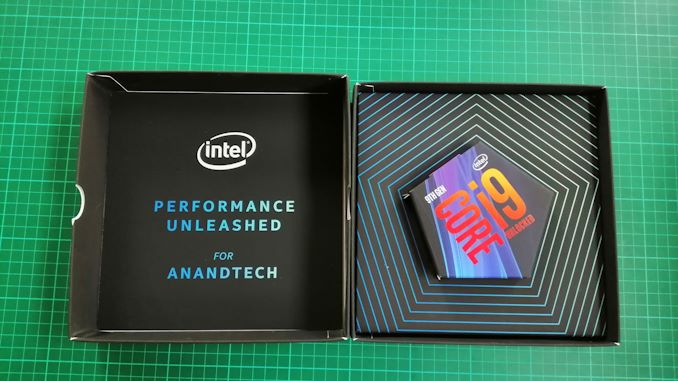
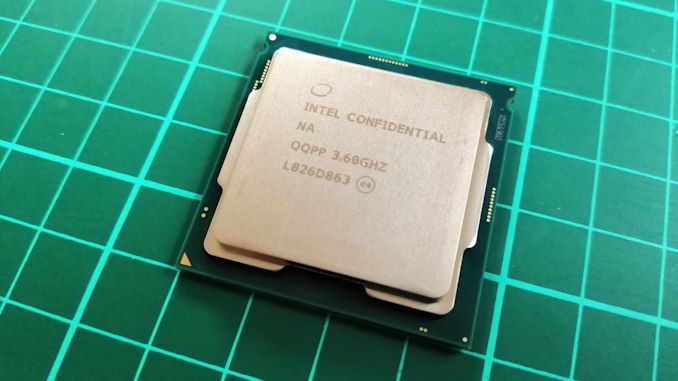

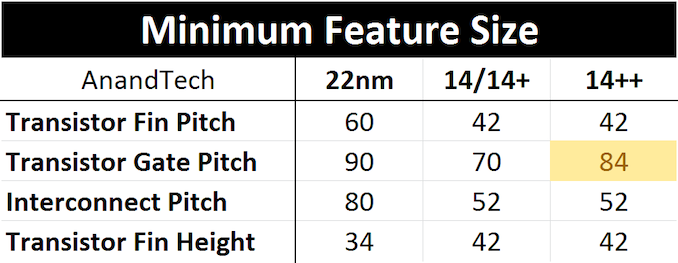
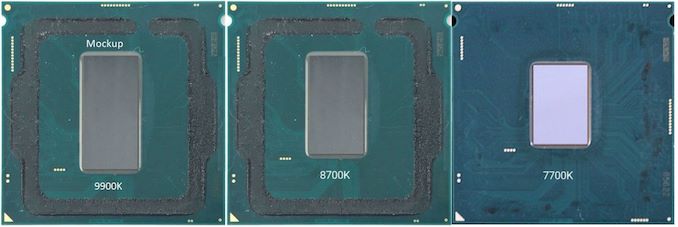








274 Comments
View All Comments
evernessince - Saturday, October 20, 2018 - link
I'm sure for him money is a fixed resource, he is just really bad at managing it. You'd have to be crazy to blow money on the 9900K when the 8700K is $200 cheaper and the 2700X is half the price.Dug - Monday, October 22, 2018 - link
Relative to how much you make or have. $200 isn't some life threatening amount that makes them crazy because they spent it on a product that they will enjoy. We spend more than that going out for a weekend (and usually don't have anything to show for it). If an extra 200 is threatening to your lively hood, you shouldn't be shopping for new cpu's anyway.close - Saturday, October 20, 2018 - link
@ekidhardt: "I think far too much emphasis has been placed on 'value'. I simply want the fastest, most powerful CPU that isn't priced absurdly high."That, my good man, is the very definition of value. It happens automatically when you decide to take price into consideration the price. I also don't care about value, I just want a CPU with a good performance to price ratio. See what I did there? :)
evernessince - Saturday, October 20, 2018 - link
A little bit extra? It's $200 more then the 8700K, that's not a little.mapesdhs - Sunday, October 21, 2018 - link
The key point being, for gaming, use the difference to buy a better GPU, whether one gets an 8700K or 2700X (or indeed any one of a plethora of options really, right back to an old 4930K). It's only at 1080p and high refresh rates where strong CPU performance stands out, something DX12 should help more with as time goes by (the obsession with high refresh rates is amusing given NVIDIA's focus shift back to sub-60Hz being touted once more as ok). For gaming at 1440p or higher, one can get a faster system by choosing a cheaper CPU and better GPU.
There are two exceptions: those for whom money is literally no object, and certain production workloads that still favour frequency/IPC and are not yet well optimised for more than 6 cores (Premiere is probably the best example). Someone mentioned pro tasks being irrelevant because ECC is not supported, but many solo pros can't afford XEON class hw (I mean the proper dual socket setups) even if the initial higher outlay would eventually pay for itself.
What we're going to see with the 9900K for gaming is a small minority of people taking Intel's mantra of "the best" and running with it. Technically, they're correct, but most normal people have budgets and other expenses to consider, including wives/gfs with their own cost tolerance limits. :D
If someone can genuinely afford it then who cares, in the end it's their money, but as a choice for gaming it really only makes sense via the same rationale if they've also then bought a 2080 Ti to go with it, though even there one could retort that two used 1080 TIs would be cheaper & faster (at least for those titles where SLI is functional).
If anything good has come from this and the RTX launch, it's the move away from the supposed social benefit of having "the best"; the street cred is gone, now it just makes one look like a fool who was easily parted from his money.
Spunjji - Monday, October 22, 2018 - link
Word.Total Meltdowner - Sunday, October 21, 2018 - link
This comment reads like shilling so hard. So hard. Please try harder to not be so obvious.Spunjji - Monday, October 22, 2018 - link
I think they placed just the right amount of emphasis on "value". Your post basically explains why it's not relevant for you in terms of you being an Intel fanboy with cash to burn. I'll elaborate.The MSRP is in the realm of irrational spending for a huge number of people. "Rational" here meaning "do I get out anything like what I put in", wherein the answer in all metrics is an obvious no.
Following that, there are a HUGE number of reasons not to pre-order a high-end CPU, especially before proper results are out. Pre-ordering *anything* computer related is a dubious prospect, doubly so when the company selling it paid good money to paint a deceptive picture of their product's performance.
Your assertion that Intel have never launched a bad CPU is false and either ignorance or wilful bias on your part. They have launched a whole bunch of terrible CPUs, from the P3 1.2Ghz that never worked, through the P4 Emergency Edition and the early "dual-core" P4 processors, all the way through to this i9 9900K which is the thirstiest "95W" CPU I've ever seen. Their notebook CPUs are now segregated in such a way that you have to read a review to find out how they will perform, because so much is left on the table in terms of achievable turbo boost limits.
Sorry, I know I replied just to disagree which may seem argumentative, but you posted a bunch of nonsense and half-turths passed off as common-sense and/or logic. It's just bias; none of it does any harm but you could at least be up-front that you prefer Intel. That in itself (I like Intel and am happy to spend top dollar) is a perfectly legitimate reason for everything you did. Just be open and don't actively mislead people who know less than you do.
chris.london - Friday, October 19, 2018 - link
Hey Ryan. Thanks for the review.Would it be possible to check power consumption in a test in which the 2700x and 9900k perform similarly (maybe in a game)? POV-Ray seems like a good way to test for maximum power draw but it makes the 9900k look extremely inefficient (especially compared to the 9600k). It would be lovely to have another reference point.
0ldman79 - Friday, October 19, 2018 - link
I'm legitimately surprised.The 9900k is starving for bandwidth, needs more cache or something. I never expected it to *not* win the CPU benchmarks vs the 9700k. I honestly expected the 9700k to be the odd one out, more expensive than the i5 and slower than the 9900k. This isn't the case. Apparently SMT isn't enabling 100% usage of the CPU's resources, it is allowing a bottleneck due to fighting over resources. I'd love to see the 9900K run against it's brethren with HT disabled.